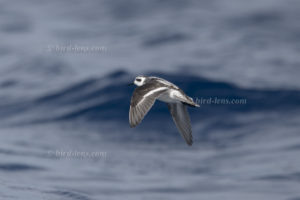 Red-necked Phalaropes (Phalaropus lobatus) are mainly known as colorful breeding birds of the Arctic tundra of Eurasia and North America. The more colorful females advertise with conspicuous courtship flights around the males, which later take care for the offspring. Following the breeding time, Red-necked Phalaropes are pronounced migratory birds. Now they change to their simple black and white non-breeding dress. In small numbers Red-necked Phalarope migrate over Germany annually. About the migration routes and the wintering areas of individual populations, however, relatively little is known. Already at the beginning of the 20th century, it was known that most of the European Red-necked Phalarope winter on the open sea. The wintering areas are dotted in the tropical seas. Well-known wintering areas are known off the west coast of South America, in the southwest Pacific and in the northwest of the Indian Ocean. A well-known area lies in the Arabian Sea. Very late, it was discovered that even on the Atlantic off the coast of West Africa Red-necked Phalarope spend the winter. It is not yet known exactly from where Red-necked Phalarope on migration over in Germany are coming and in which winter quarters they are traveling. If one previously followed the theory that there are Icelandic breeding birds on a southeastern route to Arabia, it seems today also imaginable that birds from Scandinavia rest in Germany, which winter off the West African coast.
Red-necked Phalaropes (Phalaropus lobatus) are mainly known as colorful breeding birds of the Arctic tundra of Eurasia and North America. The more colorful females advertise with conspicuous courtship flights around the males, which later take care for the offspring. Following the breeding time, Red-necked Phalaropes are pronounced migratory birds. Now they change to their simple black and white non-breeding dress. In small numbers Red-necked Phalarope migrate over Germany annually. About the migration routes and the wintering areas of individual populations, however, relatively little is known. Already at the beginning of the 20th century, it was known that most of the European Red-necked Phalarope winter on the open sea. The wintering areas are dotted in the tropical seas. Well-known wintering areas are known off the west coast of South America, in the southwest Pacific and in the northwest of the Indian Ocean. A well-known area lies in the Arabian Sea. Very late, it was discovered that even on the Atlantic off the coast of West Africa Red-necked Phalarope spend the winter. It is not yet known exactly from where Red-necked Phalarope on migration over in Germany are coming and in which winter quarters they are traveling. If one previously followed the theory that there are Icelandic breeding birds on a southeastern route to Arabia, it seems today also imaginable that birds from Scandinavia rest in Germany, which winter off the West African coast.
The breeding season of the Red-necked Phalarope starts in late May. Although the birds are now in their breeding plumage, the spring passage in Germany from early May to early June is not very noticeable. Far more noticeable is the autumn migration, which extends over a longer period from mid-July to October. Females, males and juveniles obviously migrate at different times of the year. In the northern part of Germany, in Schleswig-Holstein, a more detailed analysis of the observations showed July 21 as a median of the passage of the females, which often leave the breeding grounds right after laying the eggs. Males follow 8 days later. For juvenile birds, the 27th of August was determined as a median. Young birds are much more common on the autumn migration than adults. Depending on the breeding success, however, the number varies greatly from year to year.
Inland Germany, the species occurs only sparsely, without showing a focus on certain areas. Red-necked Phalarope usually move alone or in small groups. Groups of more than five individuals are already to be regarded as major exceptions. The fact that Red-necked Phalarope in Germany are so rare guests, might be related to the fact that probably only a small part of the European breeding birds pull over Central Europe. In addition, they can move at night and probably fly non-stop from the North Sea to the Middle Atlantic. Red-necked Phalarope are noticed e.g. from the Azores, in the middle of the Atlantic Ocean, only as rarities.
The bird of the blog-photo shows an individual in non-breeding plumage. The image was shot off-shore Cape Hatteras when you reach the Gulf Stream approx. 20 miles east of the coast of North Carolina/USA. This is less spectacular than the breeding plumage; but it is the plumage that is most likely to be expected on a pelagic sea trip. Vagrant observation in many regions associated with the winter migration routes are not uncommon. Frequently, however, in the wintering areas there is also a confusion with the closely relative, the Red Phalarope (Phalaropus lobatus).
To photograph Red-necked Phalarope the chances in Germany are best at the end of August / beginning of September. You should try it especially along the coasts. A great place to take photos in late summer and autumn are the Speicherkooge on the North Sea coast. A look in Ornitho.de, an internet-based platform for birdwatchers, shows you direction and the right time to look.
In order to satisfy the growing demand for top shots of the rarer species of Western Palearctic, Bird-lens.com has undertaken dedicated trips to nearby and distant bird areas. This is to be able to do anything to provide excellent images of the birds of the Western Palearctic. Sometimes the yield of images is enriched by bird species, which are very unlikely to show-up in the Western Palearctic. The results in images even of rare Western Palearctic birds are very good. The beautiful image of the blog is only a first impression of what you will find in behind “Picture Shop” very soon. Simply contact bird-lens.com if you need an image of a bird before the newest images are online.